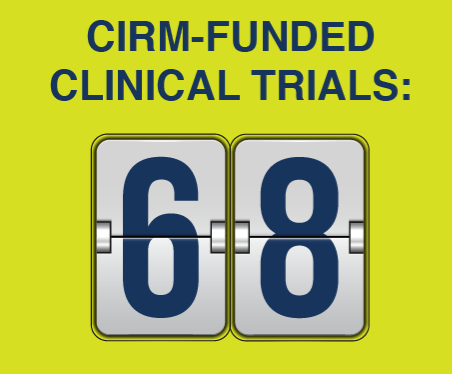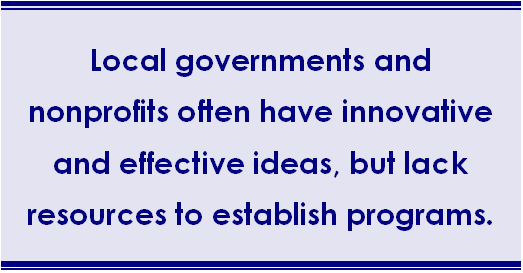You can also view this newsletter as a PDF.

As Stem Cell Research Focuses on COVID-19,
Californians Give CIRM Vote of Confidence
At the start of the millennium, studies showed the potential for stem cell therapies to cure chronic and life threatening diseases that had defied traditional therapies. However, research into this potential had yet to receive federal funding. The passage of Proposition 71 in 2004 established the California Institute for Regenerative Medicine (CIRM) to fund development of stem cell treatment research – allowing California to be a leader in this new frontier.
 CIRM is governed by the Independent Citizens’ Oversight Committee (ICOC). This 29-member board comprises leaders in life sciences and nonprofit biomedical research, as well as patient advocates for a wide range of health conditions. Members are appointed to specific roles on ICOC by the governor, lieutenant governor, state controller, treasurer, and leaders of both houses of the legislature. The chancellors of these University of California (UC) health systems each appoint an executive officer from their campus: UC Davis, UC Irvine, UC Los Angeles, UC San Diego, and UC San Francisco.
CIRM is governed by the Independent Citizens’ Oversight Committee (ICOC). This 29-member board comprises leaders in life sciences and nonprofit biomedical research, as well as patient advocates for a wide range of health conditions. Members are appointed to specific roles on ICOC by the governor, lieutenant governor, state controller, treasurer, and leaders of both houses of the legislature. The chancellors of these University of California (UC) health systems each appoint an executive officer from their campus: UC Davis, UC Irvine, UC Los Angeles, UC San Diego, and UC San Francisco.
Controller Yee is tasked with appointing:
- An executive from a California university other than the five UCs that make their own appointments;
- An executive from a nonprofit research institute outside of UC;
- An executive from a California life sciences company not actively engaged in researching or developing therapies with pluripotent or progenitor stem cells;
- A patient advocate with a focus on cancer; and
- A patient advocate with a focus on Parkinson's disease.
Controller Yee chairs the six-member Citizen’s Financial Accountability Oversight Committee (CFAOC), which reviews CIRM’s annual financial audit, the State Controller’s evaluation of that audit, and the financial practices of the Institute. The State Controller also appoints one CFAOC member.
Proposition 71 allocated $3 billion in general obligation bonds to CIRM. The funds were separated into two distinct categories: six percent was allotted for administration (approximately $180 million), and the remaining approximately $2.75 billion was made available for research grant and loan awards. Initially, CIRM funded individual projects. Beginning in 2015, CIRM switched to a more integrated systems-based approach to focus more support on internationally coordinated research efforts.
CIRM funds have built a dozen research facilities. CIRM-funded partners now have more than 75 FDA-approved clinical trials underway in various stages of progress, 68 of which were funded directly by CIRM. The remainder are funded by university-sponsored spin-off startups or biotech companies. These include drugs currently in trials for type 1 diabetes, age-related macular degeneration, heart failure, paralysis, cancer, HIV/AIDS, and dozens of other medical conditions.
COVID-19 Redirection
In March 2020 – as a pandemic spread across the globe – the ICOC convened an emergency meeting and unanimously voted to redirect CIRM’s remaining $5 million in grant funding to support stem cell research of cures for or vaccines against COVID-19. They quickly developed grant review process guidelines so funds could be deployed within 30 days of grant application approval.
Numerous studies and reports show Latino and Black communities in particular suffer higher rates of COVID-19 infections, hospitalization, and death. Wealth, poverty, employment, and housing all affect health status and access to health care, worsening the impacts of the pandemic across these underserved populations. To address the racial and economic barriers to health care access and treatments, the ICOC favorably weighted applications that included outreach and study plans incorporating robust representation of these groups in clinical trials.
CIRM’s collaborative approach to researching and testing cures and vaccines is similar to numerous international efforts being deployed around the world. Robust public and private financial support is helping fund rapid, targeted research, testing, and manufacturing and distribution options for COVID-19 cures and vaccines. Compounds in COVID-19 were quickly identified by infectious disease experts across the international scientific community, enabling them to immediately identify, repurpose, and test existing medicines already widely used for other purposes for effectiveness against this new virus. To date, testing has occurred for existing drugs used for malaria, HIV, Middle East Respiratory Syndrome (MERS), severe acute respiratory syndrome (SARS), cancer, lupus, and arthritis. As the number of people who had COVID-19 and recovered increases, robust analysis of their blood plasma has further helped inform cure and vaccine development.
In the United States, new drug options must be tested and approved in several trial phases before the U.S. Food and Drug Administration (FDA) will allow testing on humans, in order to assure the drugs do not impose other dangerous health risks. The federal Coronavirus Aid, Relief, and Economic Security Act, signed in March 2020, streamlined existing laws to help expedite the FDA approval process for COVID-19 treatments and vaccines.
As of November 16, 2020, the Milken Institute’s FasterCures COVID-19 tracker showed 319 treatments and 234 vaccines in various stages of development. The tracker includes descriptions of the various types of options being tested (e.g. DNA-based, RNA-based, inactivated viruses, live viruses, etc.), as well as the current development phase for each. With unprecedented international cooperation and alliances, and funding support from private philanthropies, there is hope for vaccines being available in the months ahead. Interim analysis of two experimental vaccines shows an effectiveness rate of better than 90 percent.
The Milken Institute’s September panel, “Predicting Pandemics: Mobilizing an Active Global Surveillance System,” suggested the current system of collaboration should become a permanent, seamless, and sustainable system to protect against future disease outbreaks.
Ongoing Funding Approved
In November 2020, Californians voted by a narrow margin to approve Proposition 14 – the Stem Cell Research Institute Bond Initiative – to build on the progress already made through CIRM on stem cell research. The initiative authorizes $5.5 billion in state general obligation bonds to fund additional grants from CIRM for stem cell and other medical research and associated expenses. Proposition 14 dedicates $1.5 billion to research for brain and central nervous system diseases and conditions including Alzheimer’s, Parkinson’s, stroke, and epilepsy. It also expands ICOC to 35 members and adds a working group focused on improving access to treatments and cures. Under Proposition 14, oversight responsibilities include review of the annual independent financial audit and CIRM's financial practices by the CFAOC and a performance audit commissioned by CIRM every three years that may be performed by the Bureau of State Audits.
CHFFA Working with Local Governments
to Build Crisis Care Capacity
Public consciousness about the prevalence of mental illness has increased over the past decade, along with a recognition that mental health issues intersect with other public policy issues including public safety and homelessness. As a national conversation about race and policing continues, so does a conversation about law enforcement’s de facto role in mental health crisis management and care. Local governments and nonprofit organizations often have innovative and effective ideas for helping their residents in crisis, which may serve as models for other regions, but lack resources to establish those programs.
The California Health Facilities Financing Authority (CHFFA), of which Controller Yee is a board member, seeks to help local governments make a difference through grants targeted at building local capacity to respond to people experiencing a mental health crisis. Originally established in 1979 to provide financial assistance to health care providers in California through loans funded by the issuance of tax-exempt bonds, CHFFA administers three grant programs targeting mental health: the Investment in Mental Health Wellness Grant Program; the Investment in Mental Health Wellness Grant Program for Children and Youth; and the Community Services Infrastructure Grant Program.
 The Investment in Mental Health Wellness Act (Chapter 34, Statutes of 2013) created, among other programs, the Investment in Mental Health Wellness Grant Program to fund a major statewide expansion of a continuum of crisis care services through grants available to counties: Mobile Crisis Support Teams (MCST), Crisis Stabilization Units (CSU), and Crisis Residential Treatment Programs (CRT). Counties applied for funding to build infrastructure, purchase equipment, and employ staff to implement their preferred local models, in order to improve access to mental health crisis services for local residents.
The Investment in Mental Health Wellness Act (Chapter 34, Statutes of 2013) created, among other programs, the Investment in Mental Health Wellness Grant Program to fund a major statewide expansion of a continuum of crisis care services through grants available to counties: Mobile Crisis Support Teams (MCST), Crisis Stabilization Units (CSU), and Crisis Residential Treatment Programs (CRT). Counties applied for funding to build infrastructure, purchase equipment, and employ staff to implement their preferred local models, in order to improve access to mental health crisis services for local residents.
MCSTs are composed of clinically trained professionals who provide support, de-escalation, and mental health services to people experiencing a mental health crisis at home or in another community setting. Their primary purpose is to keep people safe. These teams vary across jurisdictions, but they typically work closely with crisis hotlines, law enforcement, other emergency responders, and even hospital personnel. MCSTs conduct behavioral health assessments and provide interventions to people experiencing a crisis, in order to address immediate mental health needs and help determine the level of support and services needed to alleviate the crisis.
CSUs are short-term residential treatment units that provide immediate care to people experiencing a mental health or substance use disorder crisis, such as suicidal depression or psychotic behavior. The goal of a CSU is to quickly stabilize a person and refer them to community resources. CSUs are regarded as an alternative to emergency rooms, and increasingly as an alternative to incarceration for people in crisis who come into contact with law enforcement.
CRTs are a temporary alternative for people experiencing an acute psychiatric episode or intense emotional distress who might otherwise face voluntary or involuntary commitment. Programs operate under a flexible, social rehabilitation model that adapts to the needs of the client and provides appropriate individualized services. Those services may include medication monitoring; social skills and peer support; individual and group counseling; community reintegration services; and co-occurring disorder services, such as substance use disorder treatment.
CHFFA Investment in Mental Health Wellness grants have funded more than 50 new CRT and CSU projects and 110 MCSTs (vehicles and personnel) statewide that are complete and operational. Other projects are still under construction including the largest to date: Los Angeles County is building a multi-campus project that will include 15 CRTs, a CSU, and 14 MCSTs.
In 2016, the legislature expanded the Investment in Mental Health Wellness Act of 2013 to address a continuum of crisis care services for children and youth 21 years of age and under — the Investment in Mental Health Wellness Grant Program for Children and Youth (Chapter 30, Statutes of 2016). Counties were able to apply for additional funding for MCSTs, CSUs, and CRTs providing services tailored specifically to children and young adults, as well as family respite services.
That same year, the legislature also established the Community Services Infrastructure Grant Program (Chapter 33, Statutes of 2016) to expand access to jail and prison diversion programs and services for people with mental health illness or substance use disorders, and those who have suffered from trauma. Grants fund local visions for expanding mental health treatment facilities, substance use disorder treatment facilities, and trauma-centered service facilities for justice-involved individuals. Counties have partnered with local nonprofit agencies to administer programs to solve the root causes that brought individuals into contact with law enforcement. Seventeen projects have been funded, spanning 13 counties. Those projects range in size and scope, from a Day Reporting Center in Plumas County providing outpatient services to 625 justice-involved adults annually, to a 10-person residential substance use disorder treatment facility in Yolo County for justice-involved adults at risk of homelessness.
These one-time state investments yield positive results for people in mental health crisis and their communities. They will also produce lessons to inform crisis response and intervention, protecting the safety and dignity of all Californians.